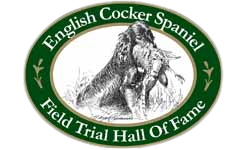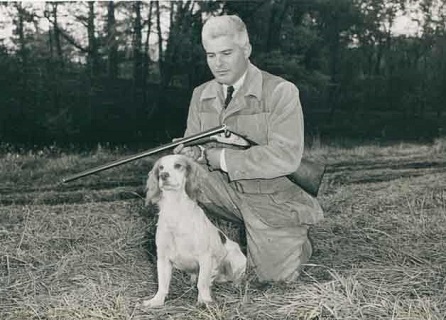FROM THE PAST
The following article was written in the early 1950s for the first handbook published by the English Cocker Spaniel Club of America, Inc. – The English Cocker Spaniel Handbook. This slim paperback book was edited by Maurie Prager, On Time English Cockers, whose aim was to have all aspects of the breed’s many talents represented therein. She enlisted the help of Alfred Winslow to write regarding he cocker field trials of that era. The following was copied form the original manuscript in the ECSCA archives.
The English Cocker In The Field
By Alfred Winslow
(Originally written for The English Cocker Spaniel Handbook, 1st edition, 1955)
Since the inception of Spaniel Field Trials in this country during the fall of 1924, a group of fine amateurs have led the sport through many difficult days, and, as we end the season of 1954, the sport is still in good hands. Today, as in the past, the basic ideal of sportsmanship exists as the dominating influence in trial management.
Pioneering in the Spaniel Field Trial sport in America can be attributed solely to a group of sportsmen who fell in love with the English Springer Spaniel as a hunting dog. The importing of this magnificent breed, the development of competent judges and the selection of Fishers Island as the location for a field trial, culminated in the holding of the first Spaniel Field Trial during the autumn of 1924. Through three years of energetic enterprise, the English Springer Spaniel fraternity developed. Several English judges came to this country to assist in the training of American judges and to guide our sportsmen in the development of their new enterprise. During this time another group was following the lead of the Springer fraternity and in 1925 the first Cocker Spaniel Field Trial was held. In 1927 the English Springer Spaniel Field Trial Association was admitted to membership in the American Kennel Club and was recognized as the parent club for Springers. During the fall of 1928 this new club held Open All-Age Stakes for English Springer Spaniels and Cocker Spaniels to inaugurate a custom which has lasted to date. Our Cockers and Springers are never combined for judgment (sic) in Championship Stakes, although the breeds are sometimes combined in the minor stakes. English field trials are run on fur and feather; whereas we confine our game for Spaniels to feather alone.
Although the breeders of the English Cocker have often wished for special designation in Field Trial catalogues, the two breeds always have been combined as COCKER SPANIELS in reports of wins. The English type spaniel, however, has been consistent in the winning columns since 1928 except for a bad period from 1949 through 1952. Magnificent American Cockers have often shown their [mettle] and their winning records have been good, but until 1949 the most consistent winner was the English Cocker. During the span from1949 to 1952 the English Cocker almost disappeared from the Eastern Field Trial scene and every trial went to an American Cocker kennel. The future of the English Cocker in American Field Trials in the Eastern United States looked mighty glum until the Fall of 1953 when an English import, Field Trial Champion Shawfield Glenfire, owned by Andrew Porter of Oxford, Maryland, stepped into the picture to win all but two trials. A repeat of his record was nearly matched in 1954 by his son, Field Trial Champion Greatford Meadowcourt Pin, owned by Albert F. Winslow of Goshen, New York, to ensure for the present, the enviable role of leadership for the English Cocker.
Breeders on the West Coast and in the Middle West have always recognized the greatness of the English Cocker and have proved their point by winning the First Cocker National held at Herrin, Illinois in 1953. H. C. McGrew, of Fortuna, California, won the First Cocker National with his Camino’s Cheetah, with a close second [to] Field Trial Champion [Wildacre] Harum Scarum, owned by Dr. and Mrs. J. D. Dodson of San Francisco, California. The 1954 National was a repeat for the English Cockers with first place going to Andrew W. Porter of Oxford, Maryland, with Field Trial Champion Shawfield Glenfire and second going to Field Trial Champion Shafylde Scamp, owned by Mrs. Alan G. Pattee of Salinas, California. These National honors must justify our contention that the English-type Cocker can successfully compete with all comers.
During the fifteenth century the Spaniel in England was divided into two groups – the Land spaniel and the Water Spaniel, but until 1892 the Springer and the Cocker were divided for work purposes only. The smaller dog was useful for hunting woodcock and the larger dog of the litter was used for bigger game. In 1892 the smaller dog – the “Cocker” was recognized by the English Kennel Club and has ever since been a separate breed.
The English Cocker is long of leg and body and is, therefore, most suited for heavy cover. The English type dog presents a spirit and drive which is a consistent characteristic of the breed. Since the inception of the Cinar Trophy for the highest pointed cocker in selected Eastern trials, the English Cocker has won four to one. By diligence in training and through selectivity in breeding, the record of the past should remain a current condition.
In England a requisite for a championship on the bench for the English Cocker is that the dog proves his qualification in the field. The test is not comprehensive, but sufficient to insure that instinct and bone structure be maintained. The American breeder has never pursued this theory, and, in consequence, the field type dog and the bench type have little similarity in appearance. The intense Field interest displayed by the English Cocker Spaniel Club of America may in time prove an influence on the field type breeders to strive for a better looking competitor. A complimentary influence from the field would also produce a hardier and bigger boned bench dog.
In our English Cocker field dog we must never overlook the vital importance of nose, marking and gentle pick-up after a bird has been shot. Thoroughness of coverage and a good workmanlike job is the standard to be sought. Returning a wounded bird after a long fall or tracking a running bird for great distances are feats requiring all the basic elements of intelligence, perseverance and instinct for which the English Cocker is renowned. The long nosed English Cocker can carry heavy pheasants over difficult terrain for long distances to deliver his burden from a gentle mouth to a grateful owner. Judging Field Trials is not an exact science and the flashy, hard driving dog is the most preferable competitor. However, the basic elements of good hunting must not be ignored for speed and drive alone. A composite is the ideal sought by all judges and owners. A dog out of control or a dog out of comfortable gun range may look snappy, but he is not helping his handler.
The English Cocker Spaniel Field Trial Champion is the best today, but his record is subject to challenge and his future depends entirely on the support of his owners and the other members of the English Cocker fraternity.
Alfred Winslow
(Re-typeset from the original typed manuscript in the 1955-56 ECSCA Archives – April 26, 2012 KR)

